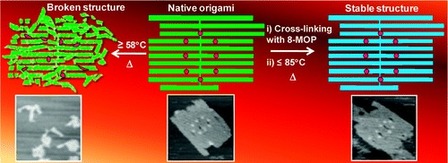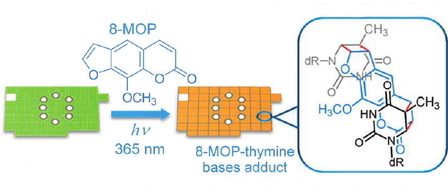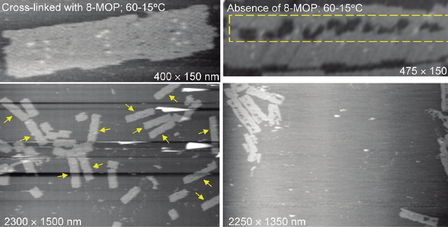
Reference: J. Am. Chem. Soc. 2011, 133 (37), pp 14488–14491
Title: Photo-Cross-Linking-Assisted Thermal Stability of DNA Origami Structures and Its Application for Higher-Temperature Self-Assembly.
Authors: A. Rajendran, M. Endo, Y. Katsuda, K. Hidaka, and H. Sugiyama
Review by: Sergii Rudiuk
Title: Photo-Cross-Linking-Assisted Thermal Stability of DNA Origami Structures and Its Application for Higher-Temperature Self-Assembly.
Authors: A. Rajendran, M. Endo, Y. Katsuda, K. Hidaka, and H. Sugiyama
Review by: Sergii Rudiuk
Introduction
Developed by Paul Rothemund, DNA origami is an interesting and rapidly developing field of nanotechnology. It consists in controlled 2- or 3-dimentional folding of long single strand DNA by Watson-Crick base pairing with multiple smaller "staple" strands. However, these structures can be used only at temperatures lower than DNA base pairs melting, i.e. ≤ 55 °C. The authors of this article focused on finding a way to increase the thermal stability of DNA origami structures.
Developed by Paul Rothemund, DNA origami is an interesting and rapidly developing field of nanotechnology. It consists in controlled 2- or 3-dimentional folding of long single strand DNA by Watson-Crick base pairing with multiple smaller "staple" strands. However, these structures can be used only at temperatures lower than DNA base pairs melting, i.e. ≤ 55 °C. The authors of this article focused on finding a way to increase the thermal stability of DNA origami structures.
Idea:
Authors used a cross-linker that can penetrate easily into the double helix and bind covalently and irreversibly to both strands of the DNA. A known psoralen (8-methoxypsoralen) ability to bind covalently DNA strands under UV irradiation was used for this purpose.
Authors used a cross-linker that can penetrate easily into the double helix and bind covalently and irreversibly to both strands of the DNA. A known psoralen (8-methoxypsoralen) ability to bind covalently DNA strands under UV irradiation was used for this purpose.

Results
Authors show that at optimal conditions (1h UV irradiation of DNA origami tails in the presence of 500 µM psoralen) the UV cross-linking of DNA strands leeded to 25-30 °C increase in DNA origami stability. The increase of thermal stability of DNA origami was used to perform one-dimentional self-assembly of 3 origami tiles at 60 °C (temperature at which the non-cross-liked tiles were found to melt). It was found that the yield of the self-assembly was increased from 40% to 61% when increasing the starting temperature of self-assembly from 50 to 60 °C.
Authors show that at optimal conditions (1h UV irradiation of DNA origami tails in the presence of 500 µM psoralen) the UV cross-linking of DNA strands leeded to 25-30 °C increase in DNA origami stability. The increase of thermal stability of DNA origami was used to perform one-dimentional self-assembly of 3 origami tiles at 60 °C (temperature at which the non-cross-liked tiles were found to melt). It was found that the yield of the self-assembly was increased from 40% to 61% when increasing the starting temperature of self-assembly from 50 to 60 °C.
